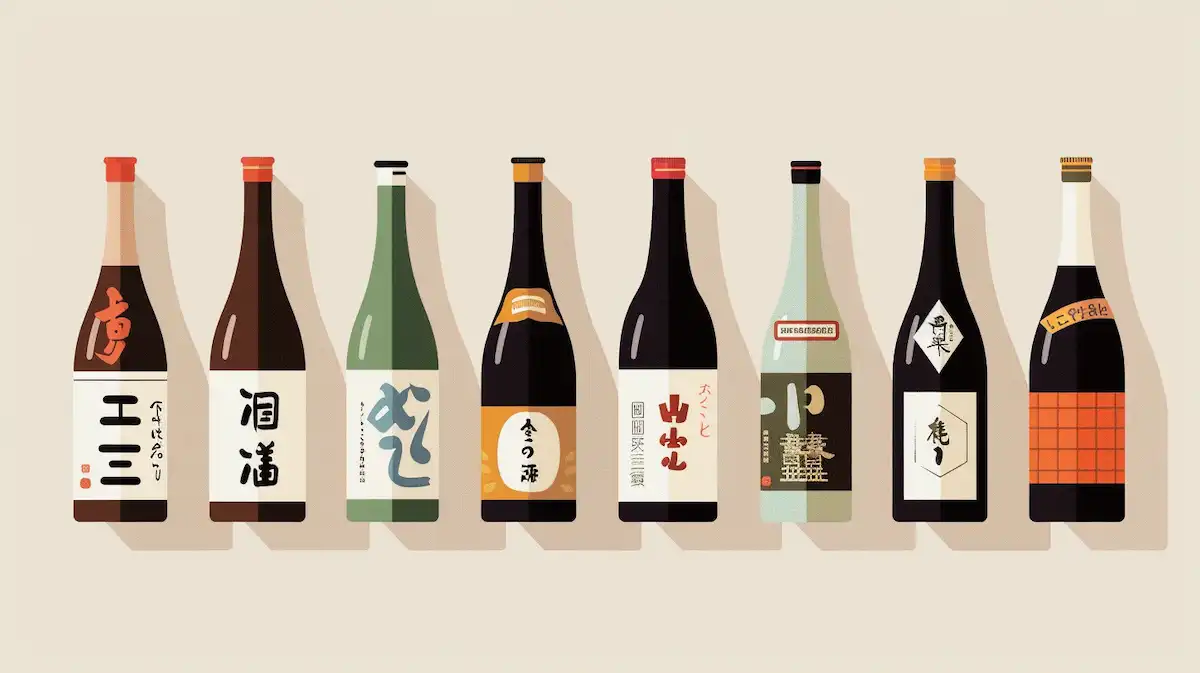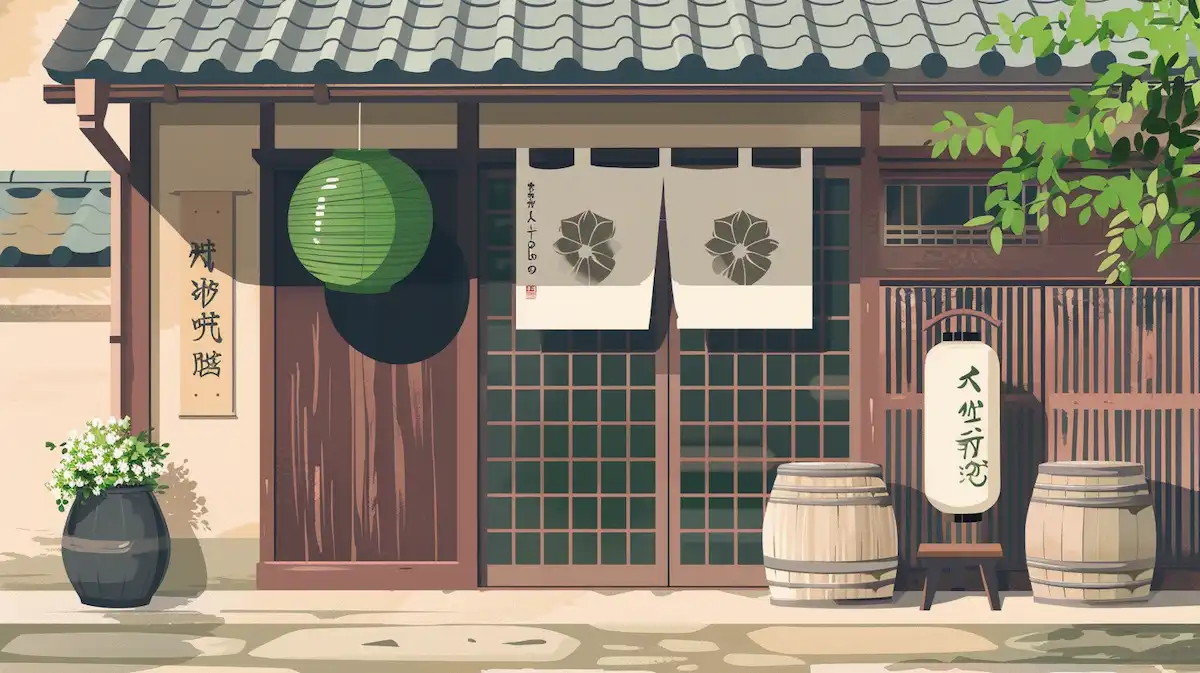杉玉を英語で説明・紹介するための基本情報と、英会話に役立つ表現をシンプルでわかりやすい英語で紹介します。
英会話ダイアローグ・関連情報・10の質問を通して、杉玉に関する英語表現を学びます。
英語
英会話ダイアローグを読む前に知っておくと良い前提知識と情報です。
- 杉玉
- 新しい酒の醸造が始まったことを示すために、日本の酒蔵の入り口に吊るされます。
- 新鮮な杉の枝で作られ、初めは鮮やかな緑色で、時間が経つにつれて茶色に変わります。
- この色の変化は、お酒が熟成していく過程を象徴しています。
- 酒造りのサイクル
- 日本の酒造りは季節に深く関わっています。
- 秋に収穫された米を使用して冬に醸造が行われ、春に新酒が完成します。
- 新酒祭り
- 春になると、新しい酒造りのシーズンを祝うために、新酒祭りや酒蔵開放などのイベントが開催されます。
- これらの祭りでは、新酒の試飲や酒蔵の見学が楽しめます。
2人が杉玉について話しています。
杉玉が新酒の完成と清潔さを象徴すること、色の変化がお酒の熟成を示すこと、そして春に新酒を祝う「新酒祭り」があることなどを話題にしています。
会話 / dialogue

Hey Key, I saw this interesting cedar ball hanging at the entrance of a local brewery yesterday. Do you know anything about it?

Oh, you’re talking about a Sugidama! They’re quite traditional here in Japan. Made from fresh cedar branches, breweries hang them to indicate that new sake has been brewed.

Interesting! I noticed it was a bright green color. Does that mean something?

Exactly! When a Sugidama is first hung, its bright green color signifies the new sake season. Over time, as the sake matures, the color fades to brown. It’s a natural indicator of the sake’s aging process.

That’s fascinating! I’ve become really interested in Sugidama and would love to learn more. Is there a specific time when breweries start making sake?

Yes, sake brewing is deeply tied to the seasons. It begins with rice harvested in autumn. The brewing process occurs during winter, and by spring, the new sake is ready. That’s why you see Sugidama being hung from late winter to early spring.

So, spring must be a special time with new sake being released. Are there any celebrations?

Definitely! Spring is when “New Sake Festivals” happen. Breweries open up for tours, and you can taste the new sake. It’s a great way to experience Japanese culture and the excitement around new sake.

Sounds like a plan! I’d love to visit one of these festivals. It would be a great opportunity to see a Sugidama in its prime and taste some fresh sake.

I’ll keep an eye out for the next festival. Let’s go together! It’s a unique experience, especially seeing how the community celebrates the new sake season.

Thanks, Key! Learning about Sugidama has given me a deeper appreciation for Japanese traditions. I’m looking forward to experiencing a festival firsthand.

My pleasure, Mack! There’s so much to explore, and the festivals are just the beginning. We’ll dive into the world of sake together.
関連情報 / related information
「杉玉」について、理解を深めるための「英語での関連情報」です。
杉玉

What is Sugidama?
Sugidama is a traditional Japanese decoration made of fresh cedar branches formed into a ball. It’s often seen hanging at the entrance of sake breweries. The green color of a new Sugidama symbolizes the start of a new sake brewing season. As time passes and the sake ages, the Sugidama slowly turns brown. This change in color indicates the aging process of the sake inside the brewery.
The Purpose of Sugidama
The main purpose of Sugidama is to show that new sake has been brewed. It also represents the purity and cleanliness necessary for brewing sake, which is very important in Japanese culture. By hanging a Sugidama, breweries tell everyone that their new sake is ready to be enjoyed. It’s a traditional way to announce the completion of sake brewing.
Sake Brewing Cycle
Sake brewing in Japan follows a seasonal cycle. It starts with rice harvested in the autumn, continues with brewing in winter, and by spring, the new sake is ready. This cycle is closely linked to the Sugidama. The new Sugidama is hung in spring to announce that the sake brewed from last autumn’s rice is now ready to be enjoyed. This tradition highlights the connection between the seasonal cycle of sake brewing and the symbolic meaning of the Sugidama.
Celebrating New Sake
In spring, when the new sake is ready, many breweries and towns in Japan celebrate with “New Sake Festivals.” These festivals are a great opportunity for people to try the new sake, visit breweries, and learn more about the sake brewing process. The festivals are a fun way for everyone to enjoy the traditions and tastes of sake together.
10の質問 / 10 questions
「杉玉」について、理解を深めるための「英語での10の質問」です。
1: What is Sugidama?
Sugidama is a traditional Japanese decoration made from fresh cedar branches formed into a ball. It is often hung at the entrance of sake breweries.
2: What does Sugidama symbolize?
Sugidama symbolizes the completion of new sake brewing. The green color of a new Sugidama indicates that a new batch of sake has been brewed.
3: Why do sake breweries hang Sugidama?
Sake breweries hang Sugidama to signify that their new sake is ready for drinking. It also serves as a visual indicator of the sake’s maturing process as the ball changes color from green to brown.
4: How does the color of Sugidama change?
The color of Sugidama changes from green to brown as the cedar branches dry out, which correlates with the aging of the new sake inside the brewery.
5: When is Sugidama typically hung at breweries?
Sugidama is typically hung at breweries in spring when the new batch of sake is ready, after being brewed in winter using rice harvested in the previous autumn.
6: How long does a Sugidama last before it needs to be replaced?
A Sugidama usually lasts for about a year before it needs to be replaced, as the color fades and the cedar branches fully dry out.
7: What is the significance of the green color in a new Sugidama?
The green color of a new Sugidama represents freshness and the beginning of the sake maturation process, symbolizing new beginnings and purity.
8: Can anyone hang a Sugidama, or is it specific to sake breweries?
While Sugidama is specific to sake breweries as part of their tradition, anyone interested in Japanese culture or sake can hang a Sugidama as a decorative element.
9: What materials are used to make Sugidama?
Sugidama is made from fresh cedar branches, which are carefully selected and bound together to form a ball.
10: How is Sugidama related to Japanese culture?
Sugidama is deeply related to Japanese culture through the sake brewing tradition. It is a symbol of craftsmanship and attention to quality in sake production, reflecting the aesthetic and ceremonial aspects of Japanese traditions.
和訳付
会話 / dialogue

Hey Key, I saw this interesting cedar ball hanging at the entrance of a local brewery yesterday. Do you know anything about it?
ねえキー、昨日地元の酒蔵の入り口に吊るされている面白い杉の球を見たんだけど、これについて何か知ってる?

Oh, you’re talking about a Sugidama! They’re quite traditional here in Japan. Made from fresh cedar branches, breweries hang them to indicate that new sake has been brewed.
ああ、それは杉玉のことだね!日本ではとても伝統的なものだよ。新鮮な杉の枝で作られていて、新しいお酒が醸造されたことを示すために酒蔵が吊るすんだ。

Interesting! I noticed it was a bright green color. Does that mean something?
面白いね!明るい緑色だったけど、それは何か意味があるの?

Exactly! When a Sugidama is first hung, its bright green color signifies the new sake season. Over time, as the sake matures, the color fades to brown. It’s a natural indicator of the sake’s aging process.
その通り!杉玉が初めて吊るされたとき、その明るい緑色は新しいお酒のシーズンを象徴しているんだ。時間が経つにつれて、お酒が熟成すると、色は茶色に変わる。それはお酒の熟成過程を自然に示す指標なんだ。

That’s fascinating! I’ve become really interested in Sugidama and would love to learn more. Is there a specific time when breweries start making sake?
それは魅力的だね!杉玉に本当に興味が湧いてきたよ。もっと学びたいな。酒蔵がお酒を造り始める特定の時期ってあるの?

Yes, sake brewing is deeply tied to the seasons. It begins with rice harvested in autumn. The brewing process occurs during winter, and by spring, the new sake is ready. That’s why you see Sugidama being hung from late winter to early spring.
ええ、お酒の醸造は季節と深く関わっているんだ。それは秋に収穫された米から始まる。醸造プロセスは冬の間に行われ、春までには新しいお酒が完成する。だから、晩冬から初春にかけて杉玉が吊るされるのを見るんだよ。

So, spring must be a special time with new sake being released. Are there any celebrations?
それなら、春は新しいお酒がリリースされる特別な時期に違いないね。何かお祝いはあるの?

Definitely! Spring is when “New Sake Festivals” happen. Breweries open up for tours, and you can taste the new sake. It’s a great way to experience Japanese culture and the excitement around new sake.
確かに!春は「新酒祭り」が行われる時期だよ。酒蔵が見学のために開放され、新しいお酒を試飲できる。日本の文化と新しいお酒への興奮を体験する素晴らしい方法だよ。

Sounds like a plan! I’d love to visit one of these festivals. It would be a great opportunity to see a Sugidama in its prime and taste some fresh sake.
それは計画に聞こえるね!これらの祭りのどれかに行ってみたいよ。最高の状態の杉玉を見て、新鮮なお酒を味わう絶好の機会になりそうだ。

I’ll keep an eye out for the next festival. Let’s go together! It’s a unique experience, especially seeing how the community celebrates the new sake season.
次の祭りをチェックしておくよ。一緒に行こう!コミュニティが新しいお酒のシーズンをどう祝うかを見るのは、特にユニークな体験だからね。

Thanks, Key! Learning about Sugidama has given me a deeper appreciation for Japanese traditions. I’m looking forward to experiencing a festival firsthand.
キー、ありがとう!杉玉について学べたことで、日本の伝統をより深く理解できるようになったよ。祭りを直接体験するのが楽しみだ。

My pleasure, Mack! There’s so much to explore, and the festivals are just the beginning. We’ll dive into the world of sake together.
どういたしまして、マック!探究することがたくさんあるよ、そして祭りはそれの始まりに過ぎない。一緒に日本酒の世界に飛び込もう。
関連情報 / related information
杉玉

What is Sugidama?
Sugidama is a traditional Japanese decoration made of fresh cedar branches formed into a ball. It’s often seen hanging at the entrance of sake breweries. The green color of a new Sugidama symbolizes the start of a new sake brewing season. As time passes and the sake ages, the Sugidama slowly turns brown. This change in color indicates the aging process of the sake inside the brewery.
杉玉とは?
杉玉は、新鮮な杉の枝を束ねて球形にした日本の伝統的な飾り物です。しばしば酒蔵の入り口に吊るされています。新しい杉玉の緑色は、新しい酒造りのシーズンの始まりを象徴しています。時間が経つにつれて、お酒が熟成すると、杉玉は徐々に茶色に変わります。この色の変化は、酒蔵内のお酒の熟成過程を示しています。
The Purpose of Sugidama
The main purpose of Sugidama is to show that new sake has been brewed. It also represents the purity and cleanliness necessary for brewing sake, which is very important in Japanese culture. By hanging a Sugidama, breweries tell everyone that their new sake is ready to be enjoyed. It’s a traditional way to announce the completion of sake brewing.
杉玉の目的
杉玉の主な目的は、新しいお酒が醸造されたことを示すことです。また、お酒を醸造する際に必要な純度と清潔さを象徴しており、これは日本の文化において非常に重要です。杉玉を吊るすことで、酒蔵は誰もが新しいお酒を楽しむ準備ができたことを告げます。これは、酒造りの完成を伝統的に発表する方法です。
Sake Brewing Cycle
Sake brewing in Japan follows a seasonal cycle. It starts with rice harvested in the autumn, continues with brewing in winter, and by spring, the new sake is ready. This cycle is closely linked to the Sugidama. The new Sugidama is hung in spring to announce that the sake brewed from last autumn’s rice is now ready to be enjoyed. This tradition highlights the connection between the seasonal cycle of sake brewing and the symbolic meaning of the Sugidama.
酒造りのサイクル
日本の酒造りは季節のサイクルに従います。秋に収穫された米を使い、冬に醸造が行われ、春までに新しいお酒が完成します。このサイクルは杉玉と密接に関連しています。春に新しい杉玉が吊るされるのは、前年の秋に収穫された米から醸造されたお酒が今や楽しむ準備ができたことをアナウンスするためです。この伝統は、酒造りの季節的なサイクルと杉玉の象徴的な意味との間のつながりを強調しています。
Celebrating New Sake
In spring, when the new sake is ready, many breweries and towns in Japan celebrate with “New Sake Festivals.” These festivals are a great opportunity for people to try the new sake, visit breweries, and learn more about the sake brewing process. The festivals are a fun way for everyone to enjoy the traditions and tastes of sake together.
新酒の祝い
春に新しいお酒が完成すると、日本の多くの酒蔵や町では「新酒祭り」でそれを祝います。これらの祭りは、人々が新しいお酒を試したり、酒蔵を訪れたり、酒造りのプロセスについてもっと学ぶ絶好の機会です。祭りは、みんなで伝統とお酒の味を一緒に楽しむ楽しい方法です。
10の質問 / 10 questions
1: What is Sugidama?
杉玉とは何ですか?
Sugidama is a traditional Japanese decoration made from fresh cedar branches formed into a ball. It is often hung at the entrance of sake breweries.
杉玉は新鮮な杉の枝を使って球形に作られた日本の伝統的な飾りです。通常、酒蔵の入り口に吊るされます。
2: What does Sugidama symbolize?
杉玉は何を象徴していますか?
Sugidama symbolizes the completion of new sake brewing. The green color of a new Sugidama indicates that a new batch of sake has been brewed.
杉玉は新しいお酒の醸造が完成したことを象徴しています。新しい杉玉の緑色は、新しいロットのお酒が醸造されたことを示しています。
3: Why do sake breweries hang Sugidama?
なぜ酒蔵は杉玉を吊るすのですか?
Sake breweries hang Sugidama to signify that their new sake is ready for drinking. It also serves as a visual indicator of the sake’s maturing process as the ball changes color from green to brown.
酒蔵は新しいお酒が飲み頃になったことを示すために杉玉を吊るします。また、球体が緑色から茶色に変わることで、お酒の熟成過程を視覚的に示す役割も果たします。
4: How does the color of Sugidama change?
杉玉の色はどのように変化しますか?
The color of Sugidama changes from green to brown as the cedar branches dry out, which correlates with the aging of the new sake inside the brewery.
杉玉の色は、杉の枝が乾燥するにつれて緑から茶色へと変化します。これは、酒蔵内の新しいお酒の熟成と関連しています。
5: When is Sugidama typically hung at breweries?
杉玉は通常、酒蔵でいつ吊るされますか?
Sugidama is typically hung at breweries in spring when the new batch of sake is ready, after being brewed in winter using rice harvested in the previous autumn.
杉玉は通常、前年の秋に収穫された米を使って冬に醸造された新しいロットのお酒が春に準備できたときに酒蔵で吊るされます。
6: How long does a Sugidama last before it needs to be replaced?
杉玉は交換が必要になるまでどれくらい持ちますか?
A Sugidama usually lasts for about a year before it needs to be replaced, as the color fades and the cedar branches fully dry out.
杉玉は色が褪せて杉の枝が完全に乾燥するまで、通常約1年間持続します。
7: What is the significance of the green color in a new Sugidama?
新しい杉玉の緑色の意味は何ですか?
The green color of a new Sugidama represents freshness and the beginning of the sake maturation process, symbolizing new beginnings and purity.
新しい杉玉の緑色は新鮮さとお酒の熟成過程の始まりを表し、新しい始まりと純粋さを象徴しています。
8: Can anyone hang a Sugidama, or is it specific to sake breweries?
誰でも杉玉を吊るすことができますか、それとも酒蔵特有のものですか?
While Sugidama is specific to sake breweries as part of their tradition, anyone interested in Japanese culture or sake can hang a Sugidama as a decorative element.
杉玉は伝統の一部として酒蔵特有のものですが、日本文化やお酒に興味がある人なら誰でも装飾要素として杉玉を吊るすことができます。
9: What materials are used to make Sugidama?
杉玉を作るためにどのような材料が使用されますか?
Sugidama is made from fresh cedar branches, which are carefully selected and bound together to form a ball.
杉玉は選び抜かれた新鮮な杉の枝を使って、丁寧に束ねて球形に作られます。
10: How is Sugidama related to Japanese culture?
杉玉は日本文化とどのように関連していますか?
Sugidama is deeply related to Japanese culture through the sake brewing tradition. It is a symbol of craftsmanship and attention to quality in sake production, reflecting the aesthetic and ceremonial aspects of Japanese traditions.
杉玉はお酒の醸造の伝統を通じて日本文化と深く関連しています。それは、日本酒の製造における職人技と品質へのこだわりを象徴し、日本の伝統の美学と儀式の側面を反映しています。
words & phrases
英会話ダイアローグと関連情報に出てきた単語・フレーズです(例文は各3つ)。

cedar : 名詞
意味: 杉。A type of evergreen tree.
(新鮮な杉の枝を使用して杉玉を作る材料として言及)
例文:
Cedar trees are known for their aromatic wood.
「杉の木は、その芳香性の木材で知られています。」
We used cedar branches to make the traditional decoration.
「伝統的な飾りを作るために杉の枝を使用しました。」
The scent of cedar is calming and is often used in spas.
「杉の香りは落ち着きがあり、スパなどでよく使用されます。」
brewery : 名詞
意味: 酒蔵。A place where beer is made commercially.
(お酒、特に日本酒を醸造する場所として言及)
例文:
We toured a local brewery to learn how beer is made.
「ビールの製造方法を学ぶために地元の酒蔵を見学しました。」
The brewery has been producing sake for over a hundred years.
「その酒蔵は100年以上にわたって日本酒を製造しています。」
Each brewery has its unique method of brewing sake.
「各酒蔵には、独自の日本酒醸造方法があります。」
fade : 動詞
意味: 色あせる、徐々に消える。To lose brightness or color; to disappear gradually.
(杉玉の色が時間と共に変化する様子を指す)
例文:
The color of the fabric will fade over time.
「布の色は時間とともに褪せます。」
As the sun set, the light began to fade.
「太陽が沈むにつれて、光が徐々に薄れ始めました。」
The memories of that summer began to fade as years passed.
「その夏の思い出は年月が経つにつれて薄れていきました。」
prime : 名詞
意味: 最高の状態、全盛期。The state of being the best or most flourishing condition.
(物事が最も良い状態にある時期や状態を指す)
例文:
The athlete said he was still in his prime and ready to compete.
「そのアスリートは自分がまだ全盛期にあり、競争する準備ができていると述べました。」
Many artists produce their best work in the prime of their lives.
「多くのアーティストは、人生の全盛期に最高の作品を生み出します。」
The garden is in its prime in early summer, with all the flowers blooming.
「庭は初夏に全盛期を迎え、すべての花が咲き乱れます。」
purity : 名詞
意味: 純度、純粋さ。The quality of being pure; free from contaminants.
(酒造りにおける清潔さや純粋さを象徴する意味合いで使用)
例文:
The purity of the water is crucial for brewing good sake.
「良い日本酒を醸造するためには水の純度が非常に重要です。」
This skincare product is known for its purity and natural ingredients.
「このスキンケア製品は、その純度と天然成分で知られています。」
He admired the purity of her voice in the performance.
「彼はその公演で彼女の声の純粋さに感嘆しました。」
詳細情報 / Further Info
関連記事(日本酒)

